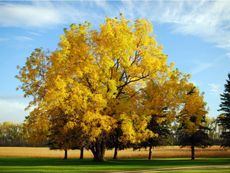Is My Black Walnut Dead: How To Tell If A Black Walnut Is Dead


Black walnuts are tough trees (Juglans nigra) that can rise to over 100 feet (30.5 m.) and live hundreds of years. Every tree dies at some point though, even if only from old age. Black walnuts also are subject to diseases and pests that can kill them at any age. “Is my black walnut dead,” you ask? If you want to know how to tell if a black walnut is dead or dying, read on. We’ll give you information on identifying a dead black walnut tree.
Is My Black Walnut Dead?
If you ask yourself whether your beautiful tree is now a dead black walnut, there must be something wrong with the tree. While it may be difficult to determine exactly what is wrong, it shouldn’t be too difficult to tell if the tree is actually dead or not.
How to tell if a black walnut is dead? The easiest way to determine this is to wait until spring and see what happens. Look carefully for signs of new growth like leaves and new shoots. If you see new growth, the tree is still alive. If not, it may be dead.
Identifying a Dead Black Walnut Before Spring
If you just can’t wait until spring to determine whether your tree is still living, here are a few tests you can try. Flex the slender branchlets of the tree. If they bend easily, they are most likely alive, which indicates that the tree is not dead.
Another way to check whether your tree is dead is to scrape back the outer bark on young branches. If the tree’s bark is peeling, lift it and look at the cambium layer beneath. If it is green, the tree is alive.
Dying Black Walnut and Fungal Disease
Black walnuts are drought and pest resistant, but they can be damaged by a number of different agents. Many dying black walnut trees have been attacked by the thousand cankers disease. It results from a combination of boring insects called walnut twig beetles and a fungus.
The beetle bugs tunnel into branches and trunks of the walnut trees, carrying spores of the canker producing fungus, Geosmithia morbidato. The fungus infects the tree causing cankers that can girdle branches and trunks. Trees die in two to five years.
Gardening tips, videos, info and more delivered right to your inbox!
Sign up for the Gardening Know How newsletter today and receive a free download of our most popular eBook "How to Grow Delicious Tomatoes."
To figure out if your tree has this disease, look carefully at the tree. Do you see insect borer holes? Look for cankers on the tree bark. An early sign of thousand cankers disease is part of the canopy’s failure to leaf out.
Other Signs of Dying Black Walnut
Inspect the tree for peeling bark. Although walnut bark is normally quite shaggy, you should not be able to pull the bark away very easily. If you can, you are looking at a dying tree.
When you begin pull back the bark, you may find it already peeled back, exposing the cambium layer. If it is pulled back all the way around the tree trunk, it is girdled, and your walnut tree is dead. A tree cannot live unless the cambium layer can transport water and nutrients from its root system to the canopy.

Teo Spengler has been gardening for 30 years. She is a docent at the San Francisco Botanical Garden. Her passion is trees, 250 of which she has planted on her land in France.
-
 Urban Composting Guide: How To Compost In The Middle Of The City
Urban Composting Guide: How To Compost In The Middle Of The CityUrban composting does not have to be daunting. You can compost in the city, and maybe even try some urban worm composting!
By Mary Ellen Ellis
-
 Shrub Diseases And Pests To Watch Out For
Shrub Diseases And Pests To Watch Out ForShrub diseases and pests can be challenging. Learn how to recognize and eradicate them before they can present a danger to your plants.
By Susan Albert
-
 Choosing Juglone Tolerant Trees – Planting Trees Near Black Walnuts
Choosing Juglone Tolerant Trees – Planting Trees Near Black WalnutsIf you want to plant trees next to black walnuts, you need ones with juglone tolerance. For more information, click here.
By Teo Spengler
-
 Harvesting Black Walnut Trees: When Do Black Walnuts Fall
Harvesting Black Walnut Trees: When Do Black Walnuts FallBlack walnuts that are ripe will almost literally fall in your lap. All you need is a tarp, some containers, and knowledge of when do black walnuts fall. This article has information that will help with harvesting black walnuts.
By Bonnie L. Grant
-
 Planting Black Walnut Trees: Learn About Black Walnut Tree Growing
Planting Black Walnut Trees: Learn About Black Walnut Tree GrowingIf you are an avid arborist or if you live in an area that was, until recently, populated by native black walnut trees, you may have questions about how to plant a black walnut tree. Also, what other black walnut tree info can we dig up? Click here.
By Amy Grant
-
 Black Walnut Tree Compatible Plants: Plants That Grow Under Black Walnut Trees
Black Walnut Tree Compatible Plants: Plants That Grow Under Black Walnut TreesThe black walnut tree is a great hardwood tree that is grown in many home landscapes. However, because of its toxicity, some plants don't do well when planted around the black walnut. Read here for tolerant plants.
By Gardening Know How